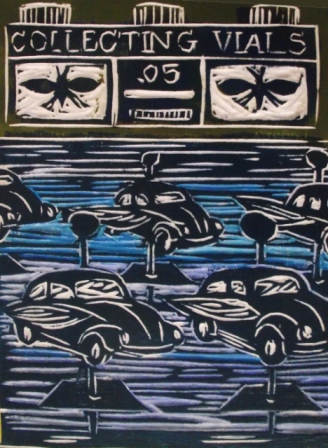2014- An Exhibition of Prints at "The Gallery@ Abbeyleix Library", Mountmellick Library and Birr Vintage and Arts Week.
Cabinets of Curiosity were the forerunners of modern museums. In Renaissance Europe they were private collections of types of objects whose categorical boundaries were yet to be defined. Objects were collected according to chosen themes and displayed without context. The context was often omitted in order to include objects that did not have a justified place in the collection or to hide the fact of the collector’s lack of knowledge. The Cabinets were a form of propaganda and glorification for their patrons. They included artificial and natural objects and often combinations of the two, to display fake, more interesting, relics.
The Curiosity Cabinet was a cross- discipline affair. Science, mysticism and natural history were connected through tenuous systems of similarity, while past and present were juxtaposed regardless of chronological history. There could be a group of round life forms; another of square .Objects within the collection could have a number of associations across categories simultaneously.
With the advent of the internet we are closer to Cabinets of Curiosity in our methods of research and browsing .Googling produces serendipitous connections between widely diverse topics. Wikipedia gives us unauthenticated knowledge. Blogs and Facebook pages are personal Cabinets of Curiosity – collections of unverified stories, opinions and images of interest to the owner that aim to encourage conversations and promote their creators. Pinterest gives us non- scientifically themed collections of images devoid of context.
Cabinets of Curiosity were the forerunners of modern museums. In Renaissance Europe they were private collections of types of objects whose categorical boundaries were yet to be defined. Objects were collected according to chosen themes and displayed without context. The context was often omitted in order to include objects that did not have a justified place in the collection or to hide the fact of the collector’s lack of knowledge. The Cabinets were a form of propaganda and glorification for their patrons. They included artificial and natural objects and often combinations of the two, to display fake, more interesting, relics.
The Curiosity Cabinet was a cross- discipline affair. Science, mysticism and natural history were connected through tenuous systems of similarity, while past and present were juxtaposed regardless of chronological history. There could be a group of round life forms; another of square .Objects within the collection could have a number of associations across categories simultaneously.
With the advent of the internet we are closer to Cabinets of Curiosity in our methods of research and browsing .Googling produces serendipitous connections between widely diverse topics. Wikipedia gives us unauthenticated knowledge. Blogs and Facebook pages are personal Cabinets of Curiosity – collections of unverified stories, opinions and images of interest to the owner that aim to encourage conversations and promote their creators. Pinterest gives us non- scientifically themed collections of images devoid of context.

























